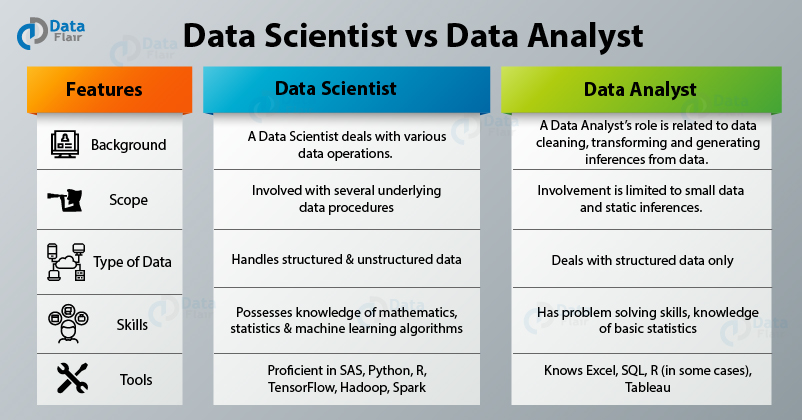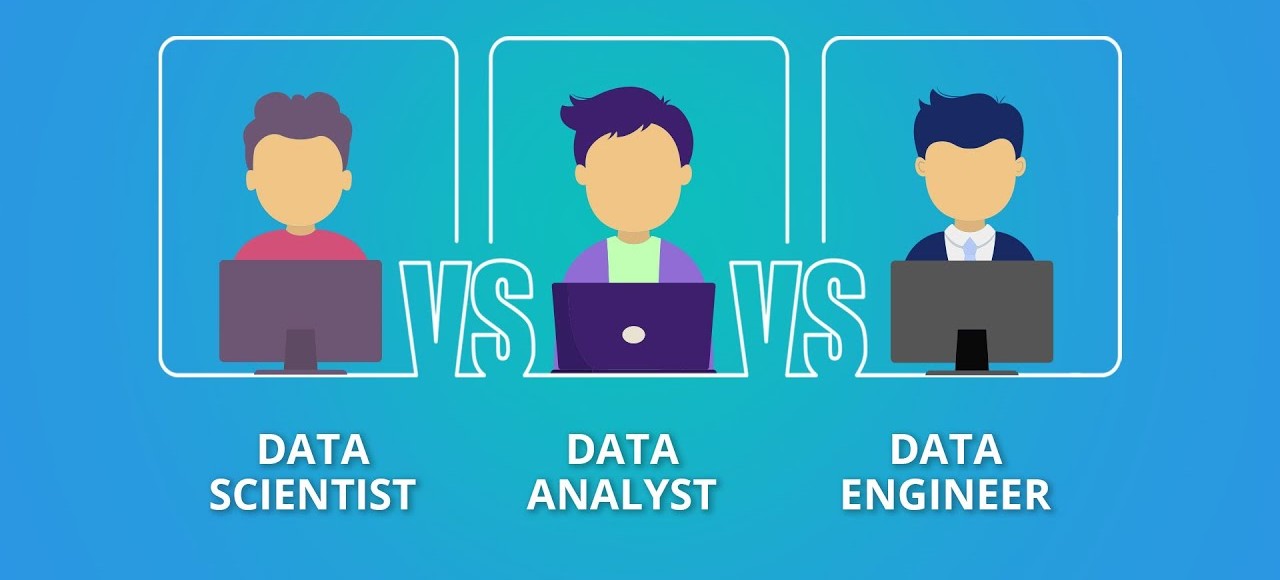Data Scientist vs Data Analyst: An Overview
Data scientists and data analysts are essential professionals in the modern data-driven economy. Both roles involve working with data to extract valuable insights and make informed decisions. However, they differ in terms of skill sets, responsibilities, and career paths. This comprehensive comparison will shed light on the similarities and differences between data scientists and data analysts, helping you understand which career may be the right fit for you.
Data Scientist: A Detailed Job Description
Data scientists are responsible for extracting valuable insights from large, complex datasets using advanced statistical modeling, machine learning, and predictive analytics techniques. They typically perform the following tasks:
- Collecting and cleaning data from various sources
- Analyzing data to identify trends, patterns, and correlations
- Applying machine learning algorithms to predict future outcomes
- Designing and implementing data visualization tools to communicate findings
- Collaborating with cross-functional teams to develop data-driven solutions
To excel in a data scientist role, one should possess a strong foundation in:
- Mathematics and statistics
- Programming languages such as Python, R, or Scala
- Data management and warehousing solutions
- Machine learning techniques and predictive modeling
- Data visualization tools and best practices
Data scientists often work on projects involving big data, artificial intelligence, and IoT, offering them opportunities to make significant contributions to their organizations.
Data Analyst: A Comprehensive Job Description
Data analysts are responsible for collecting, cleaning, and interpreting data to help organizations make informed decisions. Their primary responsibilities include:
- Gathering and processing data from various sources
- Performing statistical analysis to identify trends and patterns
- Creating reports, dashboards, and visualizations to communicate findings
- Collaborating with stakeholders to address business needs and challenges
- Ensuring data accuracy and quality
To succeed as a data analyst, one should have a solid understanding of:
- Statistics and data analysis techniques
- Data visualization tools and best practices
- SQL and database management
- Microsoft Excel and other data manipulation software
- Data mining and data warehousing solutions
Data analysts often work on projects related to market research, sales performance, and operational efficiency, allowing them to contribute to their organizations’ strategic planning and decision-making processes.
Key Differences: Data Scientist vs Data Analyst
While data scientists and data analysts share some similarities, their roles differ significantly in terms of responsibilities, required skills, and career growth opportunities. Here are the key differences:
- Responsibilities: Data scientists focus on developing predictive models, machine learning algorithms, and advanced analytics, while data analysts concentrate on interpreting data, creating reports, and visualizations to communicate findings.
- Skills: Data scientists typically need strong programming skills, advanced statistical knowledge, and experience with machine learning techniques. Data analysts, on the other hand, should have a solid understanding of data visualization, SQL, and statistical analysis.
- Projects: Data scientists often work on projects involving big data, artificial intelligence, and IoT, while data analysts typically handle projects related to market research, sales performance, and operational efficiency.
- Career Growth: Data scientists may progress to roles such as machine learning engineer, director of data science, or chief data officer, while data analysts can advance to senior data analyst, manager, or data science roles.
Understanding these differences can help you decide which career path aligns better with your personal interests, skill sets, and long-term goals.
How to Choose Between Data Science and Data Analysis
Deciding between a career as a data scientist or a data analyst can be challenging, as both roles offer unique opportunities and challenges. Here are some factors to consider when making your choice:
- Personal Interests: If you enjoy coding, machine learning, and advanced statistics, data science might be the right choice for you. However, if you prefer interpreting data, creating visualizations, and working with stakeholders, data analysis could be a better fit.
- Skill Sets: Evaluate your current skills and determine which role they align with more closely. If you have strong programming skills and experience with machine learning, consider data science. If you excel in data visualization and statistical analysis, data analysis might be the better option.
- Long-Term Goals: Consider your career aspirations and where you see yourself in the future. Data scientists typically have more opportunities for career advancement in machine learning engineering and data science management, while data analysts may progress to senior data analyst or data science roles.
Ultimately, the choice between data science and data analysis depends on your personal interests, skill sets, and long-term career goals. Both roles are in high demand and offer rewarding opportunities for professionals looking to work with data in various industries.
Popular Tools and Technologies for Data Scientists and Data Analysts
Data scientists and data analysts rely on various tools and technologies to perform their duties effectively. Here are some of the most common ones:
Programming Languages
- Python: Both data scientists and data analysts often use Python for data manipulation, analysis, and visualization due to its simplicity and extensive libraries like NumPy, Pandas, and Matplotlib.
- R: R is popular among data scientists for statistical analysis and data visualization, especially in academia and research-oriented roles.
- SQL: SQL is essential for both roles, as it enables data manipulation and retrieval from databases.
Software
- Jupyter Notebook: Jupyter Notebook is an open-source web application used by data scientists and data analysts for creating and sharing documents containing live code, equations, visualizations, and narrative text.
- Tableau: Tableau is a data visualization tool used by data analysts to create interactive dashboards and reports, making data exploration and sharing easier.
Libraries
- scikit-learn: scikit-learn is a machine learning library used by data scientists for predictive data analysis.
- TensorFlow: TensorFlow is a popular deep learning library used by data scientists for building and training neural networks.
- ggplot2: ggplot2 is a data visualization library used by data analysts and data scientists for creating elegant, customizable graphs and charts in R.
Understanding these tools and technologies can help you make informed decisions when choosing between data science and data analysis as a career.
Real-World Applications: Data Science vs Data Analysis
Data science and data analysis have numerous real-world applications across various industries. Here are some examples:
Data Science Applications
- Healthcare: Data scientists in healthcare develop predictive models to identify high-risk patients, optimize treatment plans, and improve patient outcomes.
- Finance: Financial data scientists build machine learning algorithms to detect fraud, optimize investment strategies, and manage risk.
- Retail: Retail data scientists analyze customer behavior and preferences to personalize marketing campaigns, optimize pricing strategies, and improve supply chain management.
Data Analysis Applications
- Marketing: Data analysts in marketing evaluate campaign performance, measure return on investment, and segment audiences to optimize ad targeting.
- Operations: Operations data analysts monitor and analyze production processes to identify inefficiencies, reduce costs, and improve overall performance.
- Human Resources: HR data analysts study employee performance, turnover rates, and engagement levels to inform talent management strategies and improve workforce productivity.
These examples demonstrate the significant impact of data science and data analysis on various industries, showcasing the potential value and opportunities for professionals in these fields.
Salary and Job Outlook: Data Scientist vs Data Analyst
When considering a career in data science or data analysis, it’s essential to evaluate the salary and job outlook for both roles. Several factors can influence these aspects, including regional differences, industry trends, and job market demand.
Salary
- Data Scientist: According to Glassdoor, the average base salary for a data scientist in the United States is around $113,000 per year. However, salaries can range from $85,000 to $150,000 or more, depending on factors such as location, experience, and industry.
- Data Analyst: The average base salary for a data analyst in the United States is approximately $75,000 per year, according to Glassdoor. Salaries can range from $60,000 to $100,000 or more, depending on the same factors as for data scientists.
Job Outlook
- Data Scientist: The demand for data scientists is high and continues to grow due to the increasing importance of data-driven decision-making in various industries. The U.S. Bureau of Labor Statistics (BLS) expects employment in computer and information research science, which includes data science, to grow by 15% from 2019 to 2029.
- Data Analyst: The BLS also predicts a 25% growth in employment for operations research analysts, a role closely related to data analysis, from 2019 to 2029. This growth is much faster than the average for all occupations, indicating a strong job outlook for data analysts.
In summary, data scientists generally earn higher salaries than data analysts, but both roles offer competitive compensation packages. The job outlook for both careers is positive, with strong growth expected in the coming years. When deciding between data science and data analysis, consider your personal interests, skill sets, and long-term career goals to make an informed decision.







